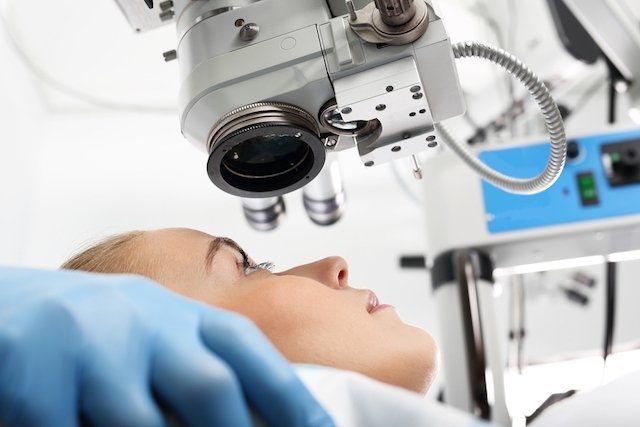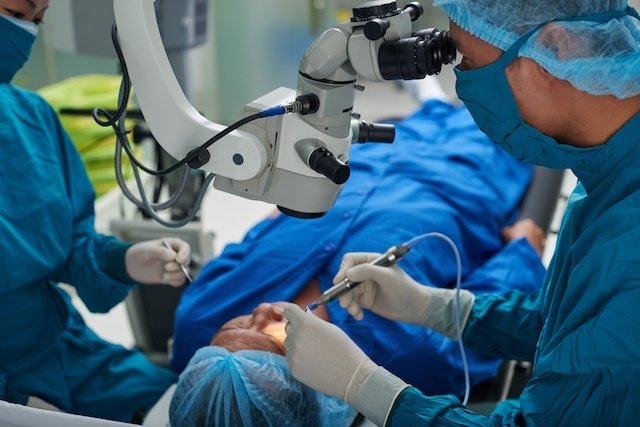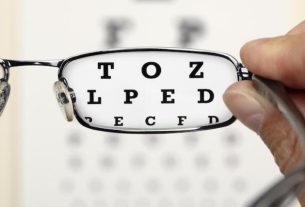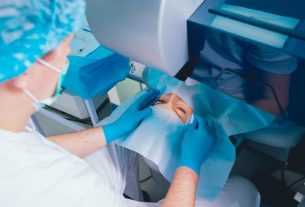PRK surgery is a type of refractive eye surgery that helps correct the degree of vision problems such as myopia, hyperopia or astigmatism, by changing the shape of the cornea using a laser that corrects the curvature of the cornea, which is capable of improve vision.
This surgery has many similarities with Lasik surgery, however, some steps of the procedure are different in each technique, and although this surgery appeared before Lasik surgery and has a longer postoperative period, it is still used in many cases, especially in people with thin corneas.
Although it is a safe surgery and brings great results for your vision, it is still possible to have a risk of post-operative complications, such as infection, corneal injuries or changes in vision, for example, and to avoid it it is necessary to take some precautions. how to use prescribed eye drops, sleep with special protective glasses and avoid swimming in public places for 1 month.

How is the surgery done
PRK surgery is performed without general anesthesia and, therefore, the person is awake throughout the treatment. However, to reduce pain and discomfort, anesthetic eye drops are used to numb the eye a few minutes before starting the procedure.
To perform the surgery, the doctor places a device to keep the eye open and then uses a substance that helps remove the thinnest, most superficial layer of the cornea. Then, a computer-controlled laser is used to send pulses of light into the eye, helping to correct the curvature of the cornea. At this point it is possible to feel a slight increase in pressure in the eye, however, it is a quick sensation because the procedure lasts about 5 minutes.
Finally, contact lenses are applied to the eyes to temporarily replace the thin layer of cornea that was removed from the eye. These lenses, in addition to protecting the eyes from dust, help prevent infections and speed up recovery.
What is post-operative recovery like?
After surgery, discomfort in the eye is very common, with a feeling of dust, burning and itching, for example, which are considered normal and a consequence of eye inflammation, improving after around 2 to 4 days.
To protect the eye, at the end of the surgery, contact lenses are placed that act as a bandage and, therefore, it is recommended to take some precautions during the first few days, such as not rubbing your eyes, resting your eyes and wearing sunglasses outdoors.
Furthermore, in the first 24 hours after surgery, it is recommended to avoid opening your eyes under the shower, not to consume alcoholic beverages, not to watch television or use the computer if your eyes are dry, in addition to being important to use the eye drops according to the doctor’s recommendations. Ophthalmologist. Other care during the recovery period is:
- Wear special protective glasses when sleeping, for the time recommended by your ophthalmologist, to avoid scratching or injuring your eyes while sleeping;
- Use prescribed anti-inflammatory medications, such as Ibuprofen, to relieve headaches and eye pain;
- After the first 24 hours, you should wash your head while taking a shower with your eyes closed;
- You should only drive again after a doctor’s advice;
- Makeup can be used again approximately 2 weeks after surgery and must be applied carefully;
- You should not swim for 1 month and you should avoid using jacuzzis for 2 weeks;
- You should never attempt to remove lenses placed in your eyes during surgery. These lenses are removed by the doctor approximately 1 week after surgery.
Daily activities can be resumed slowly after 1 week, however, those with greater impact, such as sports, should only be resumed with a doctor’s advice.

Risks of PRK surgery
PRK surgery is very safe and, therefore, complications are rare. However, one of the most common problems is the appearance of scars on the cornea, which worsens vision and creates a very blurred image. This problem, although rare, can be easily corrected with the use of corticosteroid eye drops.
Furthermore, as with any surgery, there is a risk of infection and, therefore, it is very important to always use the antibiotic eye drops prescribed by your doctor and take care with eye and hand hygiene during the recovery period. Check out the 7 essential precautions to protect your vision.
Difference Between PRK and Lasik Surgery
The main difference between these two types of surgery is in the first steps of the technique, because, while in PRK surgery the thinnest layer of the cornea is removed to allow the laser to pass through, in Lasik surgery, only a small opening (flap) is made. in the superficial layer of the cornea.
Therefore, although they have very similar results, PRK surgery is recommended for those with a thinner cornea, as, in this technique, it is not necessary to make a deeper cut. However, as a thin layer of the cornea is removed, recovery is slower to allow this layer to grow back naturally.
Furthermore, while the results of the surgery are quicker to appear with Lasik, with PRK the expected result may take a little longer due to the greater chance of exacerbated scarring. Check out more details about Lasik surgery.

Sign up for our newsletter and stay up to date with exclusive news
that can transform your routine!
Warning: Undefined array key "title" in /home/storelat/public_html/wp-content/plugins/link-whisper-premium/templates/frontend/related-posts.php on line 12
Warning: Undefined array key "title_tag" in /home/storelat/public_html/wp-content/plugins/link-whisper-premium/templates/frontend/related-posts.php on line 13



